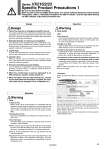
es70-44c-vx2 48 / 55
10秒後にBOOKのページに移動します
Series VX21/22/23 Specific Product Precautions 1 Be sure to read before handling. Refer to back cover for Safety Instructions. For 2 Port Solenoid Valves for Fluid Control Precautions, refer to “Handling Precautions for SMC Products” and the Operation Manual on SMC website, http://www.smcworld.com Design Design Selection Warning 1. Cannot be used as an emergency shutoff valve etc. The valves presented in this catalog are not designed for safety applications such as an emergency shutoff valve. If the valves are used in this type of system, other reliable safety assurance measures should also be adopted. 2. Extended periods of continuous energization The solenoid coil will generate heat when continuously energized. Avoid using in a tightly shut container. Install it in a well ventilated area. Furthermore, do not touch it while it is being energized or right after it is energized. 3. Liquid rings In cases with a flowing liquid, provide a bypass valve in the system to prevent the liquid from entering the liquid seal circuit. 4. Actuator drive When an actuator, such as a cylinder, is to be driven using a valve, take appropriate measures to prevent potential danger caused by actuator operation. 5. Pressure (including vacuum) holding It is not usable for an application such as holding the pressure (including vacuum) inside of a pressure vessel because air leakage is entailed in a valve. 6. When the conduit type is used as equivalent to an IP65 enclosure, install a wiring conduit etc. 7. When an impact, such as water hammer etc., caused by the rapid pressure fluctuation is applied, the solenoid valve may be damaged. Give an attention to it. Selection Warning 1. Fluid 1) Type of fluid Before using a fluid, check whether it is compatible with the materials of each model by referring to the fluids listed in this catalog. Use a fluid with a kinematic viscosity of 50 mm2/s or less. If there is something you do not know, please contact SMC. 2) Flammable oil, Gas Check the specifications for leakage in the interior and/or exterior area. 3) Corrosive gas Cannot be used since it will lead to cracks by stress corrosion or result in other incidents. 4) When a brass body is used, then depending on water quality, corrosion and internal leakage may occur. If such abnormalities occur, exchange the product for a stainless steel body. 5) Use an oil-free specification when any oily particle must not enter the passage. 6) Applicable fluid on the list may not be used depending on the operating condition. Give adequate confirmation, and then determine a model, just because the compatibility list shows the general case. 2. Fluid quality